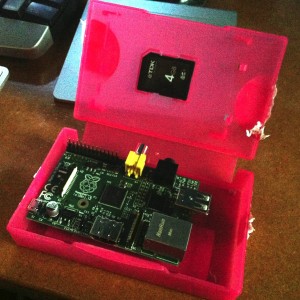In other 2012 gadget acquisition news, I got my hands on a Raspberry Pi this year, too.
Ordered in the summer, and only delivered last month, due to the high demand, it is something I have not yet had an opportunity to play with as much as I would have liked. The advantage of having to wait that long, however, has been a beefier 512 MB version of the device!
In the spirit of my recent iPad mini post, here are some first thoughts on the device:
- It is amazing how much you can do on such a tiny and inexpensive device. With the Debian wheezy build that is the Pi’s default operating system, you have access to almost the same rich range of software packages on any other Debian system. I was able to install Nginx to serve up web pages at rapid speed, and I am quite sure it would be possible to completely replicate Van Patten Media’s Managed Hosting platform that I have spent much of the year working on, even on such a device!
- It is unashamedly geeky. This will probably be enough to put off some people who have received a Pi, but perhaps who don᾿t have the support in place to best use it. It isn’t that difficult to get started, but you do need to be able to get the OS onto an SD card. For me, though, I like that opportunity that it gives you.
- It legitimises the hobbyist again. This pleases me a lot. Many great things were achieved by (originally) hobbyist hackers; re-igniting that spirit has huge potential.
There is some irony in that the Pi is, in a number of ways, the polar opposite of the iPad — it is hobbyist rather than consumerist. The Pi gives you complete control but requires some fiddling, the iPad gives you little control but is so intuitive.
I leave this year much more satisfied about the state of computing because of these two devices.
Why? There is now opportunity for both consumer hardware, and hobbyist hardware, to co-exist and complement each other.


